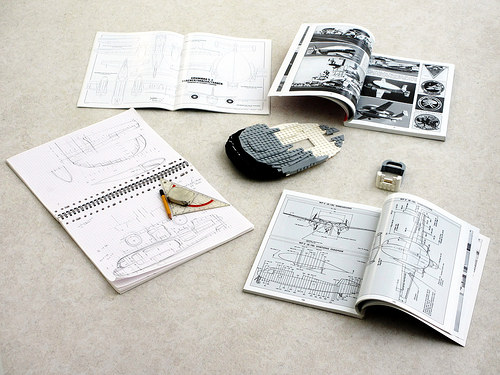Growing up, I was a huge fan of Batman: The Animated Series. One of the highlights of the show was seeing Batman fight crime in his bat-themed vehicles, including the Batwing. Jerry Builds Bricks has reproduced the Batwing in LEGO form, and it looks as slick and fast as its animated counterpart. A mixture of curved and angled slopes help form the iconic fuselage, while a combination of curved slopes and hinges are used to pull off the iconic sweeping curves of the wings. Jerry’s Batwing also looks to be the perfect size for “swooshing” back and forth.
Tag Archives: Aircraft
How to build a Pave Low helicopter with LEGO: Part 3 [Feature]
It’s done! Building my Transforming Bumblebee distracted me for a bit. However, I actually completed my Pave Low helicopter before the Beetle. In parts one and two of this series I explained how this sort of model has gotten a lot more complicated. Thanks to newer parts and techniques, the simple solutions I would have been happy with ten years ago just don’t hack it anymore. In this third and final part, I finally unveil the finished article.

Click here to continue reading…
Turning back the clock to classic aviation with the DC-3
The Douglas DC-3 is among the most iconic aircraft in the world, with a distinctive shape that’s instantly recognizable. Unfortunately for LEGO builders, that shape is also rather difficult to produce with LEGO bricks. However, that hasn’t dissuaded Vaionaut, who turned his skillful hands to this classic and produced a masterpiece. He started with an earlier design by Obuh Samateus and significantly overhauled it for accuracy and stability. Apart from the excellent shaping of the compound curves in the aircraft’s fuselage, the small touches, such as the brick-built German flag on the tail and the chrome non-custom chrome cowling on the engines, really make this model sing. The small service truck is easy to miss, but it’s a fantastic accompaniment also.
A bomber with character
It definitely takes talent and building skills to create a realistic, yet funny vehicle or aircraft. John C. Lamarck nails it with a chubby JL-450 “Wolverine” inspired by fighters and bombers of the 1940’s. A perfect choice of stickers completes its clean look very well, but it is its short and clusmy body that really creates the character.
Take to the skies in swarms with the F11 Locust
Sky-Fi is a niche branch of science fiction, essentially pushing the aesthetic and technology of WWII aircraft to the extremes. This zippy fighter by Thomas W., which he calls the F11 Locust, is a prime example of the artform, mashing up elements of numerous WWII fighters into an awesome new aircraft design. It’s rife with clever bits from a LEGO angle, too, from the minifigure hands as manifolds around the radial engine to the car mudguards with the headlight protrusions as perfect machine gun mounts. The rad sand green, orange, and white color scheme also helps bring a touch more sci-fi to the mix.
How to build a Grumman E-1 Tracer early warning aircraft from LEGO: Part 3 [Feature]
This article is the third and final installment in a series. Read about the LEGO Grumman E-1 Tracer Part 1 and Part 2 here.
In the last four weeks, I have been building a LEGO scale model of a Grumman E-1 Tracer aircraft. Part 1 described how I planned the build, and part 2 dealt with how I built some of the difficult bits; in this, the third and final part, I explain how I built the last bits, and present the finished model.
For weeks this build seemed to progress really slowly. I know that for some builders September means building huge spaceships. It took me most of this month to build just the radome, the nose, the wings and the engine nacelles. When I started building the fuselage, however, it felt like I had reached the home stretch. All of a sudden things went really quickly. Building the final parts wasn’t necessarily easy, but certainly easier. It was great to see the collection of separate sections come together into something that looked like an aircraft. The anticipation of seeing the end result motivated me. So, here it is.
Continue reading
How to build a Grumman E-1 Tracer early warning aircraft from LEGO: Part 2 [Feature]
This article is Part 2 of an ongoing series. Read about the LEGO Grumman E-1 Tracer Part 1 here.
About two weeks ago, I started building a new aircraft model: a Grumman E-1 Tracer. Because some of you might like to know how one might build such a LEGO scale model, I am documenting my process in a short series. In the first part I described why I decided to build such an oddball aircraft in the first place and how I plan a build like this. I also explained that I usually start by building the difficult bits. A few of those are the subject of this article.
The Tracer’s wings are not quite perpendicular to the fuselage. This wouldn’t be much of an issue if the engine pods and the main undercarriage weren’t attached to them. I have built angled wings before, including some rather large ones. In practice, however, it is almost impossible to mount the wings using hinges and also have them carry much of the model’s weight. Furthermore, if I were to build the wings at some weird angle, I would then have to figure out how to align the engines attached to still be parallel with the fuselage. My solution is to attach both engines directly to each other and also to the fuselage using a bridge structure. I built this bridge perpendicular to the fuselage using plates. I then put the actual wings on top of it. By combining 2×3 and 2×4 wedge plates I filled in the gaps where the tops of the engines join the wing. Getting everything to fit nicely involved a lot of trial-and-error, but it works.
Per Ardua Ad Astra — LEGO Supermarine Spitfire takes flight over Britain
Per Ardua Ad Astra — “Through adversity to the stars” — the motto of the UK’s Royal Air Force, and what sprang to mind as Paul Nicholson‘s LEGO version of a Supermarine Spitfire thundered into view. For a small model, the shaping is pretty good, capturing the iconic elliptical wing shape well, and there’s a nice mix of colours to create a camouflage effect. And the use of 1×1 “cheese slopes” delivers the essential touch of the raked exhausts down the sides of the engine. I’m less of a fan of the forced-perspective base — I think the presentation would have benefitted from further separation of the plane from the ground, and perhaps a tighter depth of field pushing the background out of focus. However, despite those minor photography gripes the plane itself is a cracking model, immediately recognisable and eminently swooshable.
How to build a Grumman E-1 Tracer early warning aircraft from LEGO: Part 1 [Feature]
Question: “How did you build this?” Answer: “By making a plan and sticking to it.” The question is one that many LEGO builders will have had. The answer, in my case, is completely true, but also wholly inadequate. So, in an attempt to give a more fulfilling answer, in the next few weeks I’ll occasionally write a piece detailing the progress on my latest project: a scale model of a Grumman E-1 Tracer aircaft.
Some builders start by experimenting with a few pieces until they find a combination they like. They then build the rest of the model from there. I’m not one of those people. I plan my builds. “Doesn’t that kill spontaneity?”, you may wonder. Well yes, it does, but if I wanted to build a scale model of a complex object such as an aircraft spontaneously, it simply wouldn’t happen. My brain doesn’t work like that. Furthermore, I enjoy looking at pictures of aircraft, reading about them and thinking about which to build and how to build it. To me this is half the fun. If If I am spontaneous, I’ll build car.
Read more about how Ralph plans and design his LEGO aircraft
Dominate the skies with this LEGO F-4 Phantom II
Military jets are a popular subject for LEGO model-makers and represent a particular challenge with their swept back wings and curved fuselages — difficult shapes to recreate in bricks. But Evan M seems up to the challenge, presenting this fabulous minifig-scale F-4 Phantom, decked out in US Navy Vietnam-era livery.
Evan has made great use of some of the new angled tile parts to give the wings a smooth leading-edge, but there’s excellent brickwork all over the model. We’ve seen fimpressive LEGO Phantoms before, notably James Cherry’s astonishing 6,000-piece LEGO F-4 Phantom, but this is one of the best fast jet models I’ve seen at this sort of scale. The overall shaping and the model’s sleek lines are readily apparent in this side view, as is the smart integration of the twin cockpit pieces and the subtle angle up on the wing tips. Retractable landing gear and a full load-out too! Fantastic stuff.
Gone with the wind
Although not based on a specific aircraft, the latest model from Finnish builder Tino Poutiainen accurately replicates the wild, “held together with string and dreams” frontier of the early days of manned flight. Like the real-life Wright Flyer, Baldwin Red Devil, and other early turn-of-the-20th-century experimental aeroplanes, Tino’s model appears rickety, thin, and massively unsafe: he did a superb job of making the whole thing look like it’s going to fall apart as soon as its wheels leave the ground.
Dog fighting in the sky over Vietnam with the Fishbed and the Phantom II
Even though the North Vietnamese didn’t have much of an air force at the start of the air war over Vietnam in 1964, with Soviet assistance they were soon able to present US pilots with a few surprises. Their MiG-17 fighters were old-fashioned and only had guns as their armament. The jets were small, though, and well-suited to out-turn heavier US jets mostly optimised for higher speeds. Peter Dornbach has built the more modern MiG-21, known as the “Fishbed” in the West. This entered Vietnamese service in 1966.
Peter’s model has a retractable undercarriage, opening cockpit and a brick-built representation of the characteristic camouflage used by the Vietnam People’s Air Force. With its higher speed and two AA-2 Atoll air-to-air missiles the Fishbed was typically used in hit-and-run attacks. The US countered this threat using the F-4 Phantom II. This wasn’t particularly agile, but had powerful twin engines. Its crews were taught to use these as an advantage against the MiGs by manoeuvring in the vertical.
The particular example built by Evan Melick is “Showtime-100”, a US Navy F-4J flown by Randy “Duke” Cunningham and William Driscoll who put this tactic to practice shooting down three Vietnamese fighters during a famous mission in May of 1972. Added to their two previous victories, this made them the US Navy’s first and only aces of the Vietnam war. Like most US Navy aircraft from the time period, it had distinctive squadron markings, which Evan recreated on his model using a mix of brick-built patterns, custom vinyl stickers and water-slide decals intended for 1/48 scale models. Note his clever use of new 45 degree angled tiles to build studless leading edges on the jet’s wings.
Both jets are part of a Vietnam collaboration by about a dozen builders, including yours truly, which will be on display at Brickfair Virginia in a little less than three weeks.












